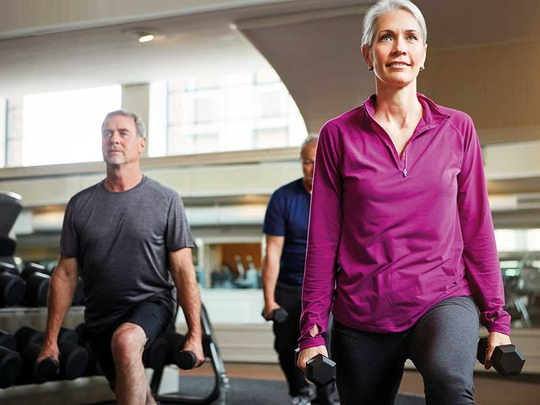
Trying to stay trim as you age? Surprisingly, if you’re cutting calories to lose weight, adding weights to your weight loss regimen could be more effective than beginning a walking programme, according to a new study that adds to growing evidence that weight training is important for vigorous ageing.
Successful weight loss is never easy, as most of us know from experience, and becomes more difficult with age. Instead of losing or maintaining weight as we grow older, most of us gain a kilo or two each year during middle age.
At the same time, we also often begin naturally to lose some of our muscle mass, so that our bodies wind up increasingly composed of fat.
This change in body composition matters, because fat tissue is less metabolically active than muscle. As the percentage of our body composed of fat tissue rises, our metabolic rates fall and we burn fewer calories throughout the day, predisposing us to continued weight gain.
We also become less strong, of course, as our muscles shrink.
So most experts agree that the ideal weight-loss programme for most people would maximise fat loss while sparing muscle mass.
But this balance is difficult to achieve, since, typically, when we drop half a kilo while dieting, as much as a third of that loss can come from muscle, with the rest composed of fat.
Some past studies have hinted that exercising while cutting calories might help to lessen this muscle loss. But most of those studies have been small and involved relatively young people or only one gender.
For the new study, which was published last month in Obesity, researchers at Wake Forest University in Winston-Salem, North Carolina, and other institutions decided to focus on both men and women older than 60. They also set out to enroll African-American as well as the Caucasian participants most earlier studies used.
In the end, they wound up with 249 participants who were overweight or obese and sedentary.
The researchers measured their body compositions and leg-muscle strength and assessed their diets.
Then they randomly assigned the volunteers to one of three groups. Some began a basic calorie-reduction plan, during which they cut their food intake by an amount expected to help them lose 7 to 10 per cent of their body weight over the coming months. For most of them, this meant a reduction of about 300 calories per day.
The members of this group were asked not to exercise.
Another group also cut their calorie intake. But at the same time, they began a supervised aerobic exercise programme consisting of walking briskly on a track for 45 minutes four times per week.
The third group likewise reduced calories but also began a weight-training programme. Four times a week, they worked with trainers at a gym to complete a full-body resistance training routine using weight machines.
All of the volunteers continued their particular programme for 18 months. By the end of that time, everyone had dropped weight. But there were notable differences in the amount and type of weight that had been lost in each group.
The men and women in the group that had cut calories but not worked out had lost an average of about five and a half kg each.
Body-composition scans
Those who had cut calories and walked had dropped far more weight, about 9 kg each, while those who had dieted and weight trained likewise had lost about 9 kg per person.
But the weight loss among walkers and weight trainers was qualitatively different, their new body-composition scans showed. The weight trainers had lost a little bit of muscle and 8 kg of fat, while the walkers had dropped more of muscle and less of fat.
The group that had dieted and not exercised had lost about 900 grams of muscle.
In effect, the walkers had lost more muscle mass in total and as a percentage of their weight loss than either of the other two groups, including those who had not exercised at all.
That finding surprised the researchers, said Kristen M. Beavers, an assistant professor of health and exercise science at Wake Forest and the study’s lead author.
It would have worried them, too, she said. But subsequent tests of muscular strength showed that, relative to their new, lower body weights, the men and women who had exercised in any way had stronger legs than they had had 18 months before.
Those who had remained sedentary did not have stronger legs.
So although they had dropped some muscle mass, the walkers had gained leg strength. (The researchers did not test upper-body strength.)
But overall, the study’s results imply that walking could have limitations as a weight-loss aid for older dieters, Beavers said.
“Walking is excellent exercise,” she says. “But it looks as if it might not produce enough of an anabolic signal to really spare muscle mass during weight loss.” In other words, it might not prompt older people’s bodies to hold on to muscle as effectively as weight training seems to do, she said.
Of course, an experiment like this cannot tell us why, at the molecular level, different types of exercise alter the composition of weight loss or whether the results would be the same for younger people or those who were not unfit.
But the results do suggest, Beavers says, that for healthy weight loss, many of us might consider at least occasionally walking to the gym and, once there, picking up some weights.
–New York Times News Service













